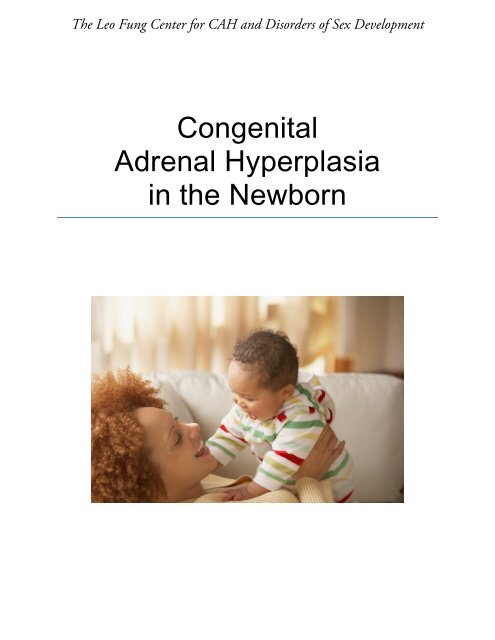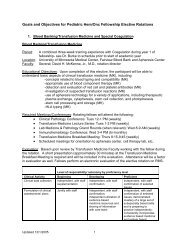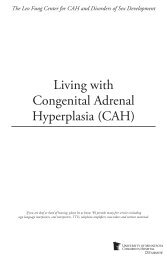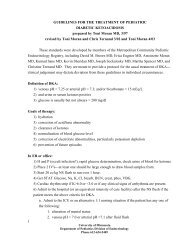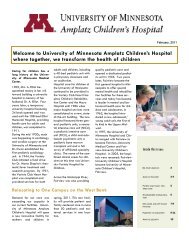Congenital Adrenal Hyperplasia in the Newborn - Department of ...
Congenital Adrenal Hyperplasia in the Newborn - Department of ...
Congenital Adrenal Hyperplasia in the Newborn - Department of ...
- No tags were found...
You also want an ePaper? Increase the reach of your titles
YUMPU automatically turns print PDFs into web optimized ePapers that Google loves.
The Leo Fung Center for CAH and Disorders <strong>of</strong> Sex Development<strong>Congenital</strong><strong>Adrenal</strong> <strong>Hyperplasia</strong><strong>in</strong> <strong>the</strong> <strong>Newborn</strong>
ContentsIntroduction 1What is congenital adrenal hyperplasia? 1Types <strong>of</strong> CAH 3Diagnos<strong>in</strong>g CAH <strong>in</strong> newborns 4Treat<strong>in</strong>g CAH 5Untreated CAH 7CAH <strong>in</strong> children and young adults 8Frequently asked questions 9Glossary 11Resources 13Acknowledgments 14
<strong>Congenital</strong> <strong>Adrenal</strong> <strong>Hyperplasia</strong> <strong>in</strong> <strong>the</strong> <strong>Newborn</strong> 1IntroductionThis handbook will provide you and your family <strong>in</strong>formation about congenital adrenalhyperplasia (CAH). While this guide will not answer all <strong>of</strong> your questions, it will provide basicmedical facts that will help you to talk to your doctors.It is important to know that CAH cannot be cured but it can be treated. Your child will need totake medic<strong>in</strong>e for <strong>the</strong> rest <strong>of</strong> his or her life. If your child takes this medic<strong>in</strong>e, he or she shouldhave a completely normal life <strong>in</strong> every way.Successful treatment requires teamwork between you and your doctor. The doctor will monitoryour child <strong>in</strong> order to know what dose <strong>of</strong> medic<strong>in</strong>e is needed. We ask that you give your baby<strong>the</strong> medication on <strong>the</strong> schedule recommended by your doctor.Your family is not alone. The Leo Fung Center for CAH and Disorders <strong>of</strong> Sex Development(DSD) at University <strong>of</strong> M<strong>in</strong>nesota Amplatz Children’s Hospital, provides a large network <strong>of</strong>support, <strong>in</strong>clud<strong>in</strong>g medical specialists, <strong>the</strong>rapists and counselors who all have expertise <strong>in</strong> car<strong>in</strong>gfor patients with CAH.What is congenital adrenal hyperplasia?Let’s beg<strong>in</strong> by exam<strong>in</strong><strong>in</strong>g each word.• <strong>Congenital</strong> means exist<strong>in</strong>g at birth (<strong>in</strong>herited).• <strong>Adrenal</strong> means that <strong>the</strong> adrenal glands are <strong>in</strong>volved. These glands are located above <strong>the</strong>kidneys. The adrenal glands produce three important hormones - cortisol, aldosterone andandrogen. Each <strong>of</strong> <strong>the</strong>se hormones has an important job <strong>in</strong> <strong>the</strong> body.• <strong>Hyperplasia</strong> means an abnormal <strong>in</strong>crease <strong>in</strong> <strong>the</strong> number <strong>of</strong> cells that make up an organ ortissue. This causes <strong>the</strong> organ or tissue to enlarge.
<strong>Congenital</strong> <strong>Adrenal</strong> <strong>Hyperplasia</strong> <strong>in</strong> <strong>the</strong> <strong>Newborn</strong> 2<strong>Congenital</strong> adrenal hyperplasia, <strong>the</strong>n, is an <strong>in</strong>herited disorder that affects <strong>the</strong> production <strong>of</strong>certa<strong>in</strong> hormones and causes <strong>the</strong> adrenal glands to become too big (hyperplastic).Hormones <strong>in</strong>volved <strong>in</strong> CAHCortisol (stress hormone): Helps control blood pressure,blood sugar and heart function. The body uses more cortisoldur<strong>in</strong>g times <strong>of</strong> stress, <strong>in</strong>jury and <strong>in</strong>fection. Not hav<strong>in</strong>g enoughcortisol can be life threaten<strong>in</strong>g because it can lead to shock(dangerously low blood pressure), which is also known as an‘‘adrenal crisis.’’Aldosterone (salt-sav<strong>in</strong>g hormone): Helps balance water,sodium and potassium <strong>in</strong> <strong>the</strong> body. Without enough aldosterone,<strong>the</strong> body can’t hold on to sodium and water.Androgens (male hormones, such as testosterone): Bothmales and females have androgens. A male fetus needs androgensfor normal genital development.However, a female fetus should not have androgens or hergenitals may not form normally (<strong>the</strong>y may become more male <strong>in</strong>appearance).
<strong>Congenital</strong> <strong>Adrenal</strong> <strong>Hyperplasia</strong> <strong>in</strong> <strong>the</strong> <strong>Newborn</strong> 3Types <strong>of</strong> CAHCAH may be ‘‘classical’’ or ‘‘non-classical.’’ Your doctor will tell you which form <strong>of</strong> CAH yourchild has.Classical CAHIn classical CAH, <strong>the</strong> body produces more androgens (male hormones) than it needs. At <strong>the</strong>same time, <strong>the</strong>re is too little cortisol (stress hormone) and sometimes too little aldosterone (saltsav<strong>in</strong>g hormone). This type <strong>of</strong> CAH occurs <strong>in</strong> about 1 out <strong>of</strong> every 15,000 births.There are two forms <strong>of</strong> classical CAH: salt-wast<strong>in</strong>g and simple viriliz<strong>in</strong>g.• Salt-wast<strong>in</strong>g CAH is <strong>the</strong> more common-----and severe-----form. With salt-wast<strong>in</strong>g CAH, toomuch sodium and water are lost through ur<strong>in</strong>e, and <strong>the</strong> amount <strong>of</strong> potassium <strong>in</strong> <strong>the</strong> body<strong>in</strong>creases, caus<strong>in</strong>g dehydration (loss <strong>of</strong> fluids) and very low blood pressure.• Simple-viriliz<strong>in</strong>g CAH does not cause <strong>the</strong> body to lose sodium and water. Therefore, it isless severe than salt-wast<strong>in</strong>g CAH. Like salt wasters, simple virilizers produce too manyandrogens.Both salt-wast<strong>in</strong>g and simple-viriliz<strong>in</strong>g CAH patients may develop an ‘‘adrenal crisis’’ dur<strong>in</strong>gperiods <strong>of</strong> physical stress (illness, surgery or trauma). This is a life-threaten<strong>in</strong>g situation andurgent medical care is needed.Diagnosis <strong>in</strong> girls:In girls, both k<strong>in</strong>ds <strong>of</strong> classical CAH tend to be detected at birth because <strong>the</strong> genitals may notlook normal. (Often <strong>the</strong>y look more like boys’ genitals.) This is because <strong>the</strong>ir adrenal glandsproduced too many androgens (male hormones) <strong>in</strong> <strong>the</strong> womb. A typical female fetus does notproduce this many androgens.Diagnosis <strong>in</strong> boys:In <strong>the</strong> male fetus, <strong>the</strong> testes already produce androgens. So if a few more androgens come from<strong>the</strong> adrenal glands, <strong>the</strong> genitals may look only slightly different at birth. (The scrotum may bemore brownish <strong>in</strong> color, and <strong>the</strong> penis may be a little larger). <strong>Newborn</strong> screen<strong>in</strong>g is <strong>of</strong> particularvalue <strong>in</strong> boys, because <strong>the</strong>y have no outward signs <strong>of</strong> <strong>the</strong> disease, and yet are at risk <strong>of</strong> "adrenalcrisis" which can be prevented by early diagnosis and medical treatment.
<strong>Congenital</strong> <strong>Adrenal</strong> <strong>Hyperplasia</strong> <strong>in</strong> <strong>the</strong> <strong>Newborn</strong> 4Non-classical CAHNon-classical CAH (NC-CAH) is milder than classical CAH. It is <strong>of</strong>ten referred to as “lateonset”CAH, because symptoms do not appear until later <strong>in</strong> life. Currently, this type <strong>of</strong> CAH isnot detected through newborn screen<strong>in</strong>g <strong>of</strong> <strong>in</strong>fants.<strong>Newborn</strong>s with NC-CAH do not have genital changes. Instead, <strong>the</strong> disease is diagnosed when<strong>the</strong> effects <strong>of</strong> excess androgen appear <strong>in</strong> childhood (rapid growth, early puberty) or dur<strong>in</strong>g <strong>the</strong>teenage or adult years (too much face and body hair, severe acne, irregular periods).Diagnos<strong>in</strong>g CAH <strong>in</strong> newbornsMost babies with classical CAH will beidentified through <strong>Newborn</strong> Screen<strong>in</strong>g.All states, <strong>in</strong>clud<strong>in</strong>g M<strong>in</strong>nesota, perform<strong>Newborn</strong> Screen<strong>in</strong>g for CAH. Thissimple blood test is done when <strong>the</strong> baby is24 to 48 hours old.Your doctor may recommend o<strong>the</strong>r tests(hormones, electrolytes) to confirm <strong>the</strong><strong>Newborn</strong> Screen<strong>in</strong>g result <strong>of</strong> CAH. Later,your doctor may recommend genetic(DNA) tests. This requires ano<strong>the</strong>r bloodtest. Family members may have this test aswell. In fact, it is important for both maleand female family members to be tested if<strong>the</strong>y are th<strong>in</strong>k<strong>in</strong>g about hav<strong>in</strong>g a baby.The genetic test for CAH may provide<strong>in</strong>formation that is useful for <strong>the</strong> doctor <strong>in</strong>car<strong>in</strong>g for <strong>the</strong> baby’s health.
<strong>Congenital</strong> <strong>Adrenal</strong> <strong>Hyperplasia</strong> <strong>in</strong> <strong>the</strong> <strong>Newborn</strong> 5Treat<strong>in</strong>g CAHTreatment <strong>in</strong>volves replac<strong>in</strong>g hormones that <strong>the</strong> body cannot produce itself and keep<strong>in</strong>g <strong>the</strong>body from mak<strong>in</strong>g too much <strong>of</strong> o<strong>the</strong>r hormones. This means your child will need to takemedic<strong>in</strong>e regularly for <strong>the</strong> rest <strong>of</strong> his or her life.While this appears simple, long-term success requires teamwork between your family and yourdoctors. You will need to:• Make sure that your child takes <strong>the</strong> medic<strong>in</strong>e faithfully.• Keep all appo<strong>in</strong>tments with your child’s doctors.• See a pediatric endocr<strong>in</strong>ologist (a children’s doctor who specializes <strong>in</strong> hormones) to makesure <strong>the</strong> medic<strong>in</strong>e is work<strong>in</strong>g.Because each person is different, treatment is tailored to each patient. Your child will need totake medic<strong>in</strong>e two to three times a day. This will ensure that your child ma<strong>in</strong>ta<strong>in</strong>s normal energylevels, <strong>the</strong> right balance <strong>of</strong> sodium and water, and normal growth and development.Medic<strong>in</strong>esThere are two k<strong>in</strong>ds <strong>of</strong> medic<strong>in</strong>es used to treat CAH. These medic<strong>in</strong>es are steroids. They replace<strong>the</strong> hormones that are not produced by <strong>the</strong> adrenal glands. Your doctor will tell you whichmedic<strong>in</strong>es are right for your child. They will need to be taken every day.Children who have classical CAH need extra steroids dur<strong>in</strong>g periods <strong>of</strong> <strong>in</strong>creased physical stress.(Emotional stress does not require extra medic<strong>in</strong>e.) The extra dose <strong>of</strong> steroids is called a stressdose. It can range from two to three times <strong>the</strong> normal daily dose depend<strong>in</strong>g on <strong>the</strong> severity <strong>of</strong><strong>the</strong> stress to <strong>the</strong> body.Ask your doctor how much medic<strong>in</strong>e to give <strong>in</strong> a stress dose. You may request a letter from yourdoctor with specific <strong>in</strong>structions. Give this to <strong>the</strong> appropriate person at your child’s daycarecenter, school or camp. You may also request an ‘‘emergency letter.’’ Give this to <strong>the</strong> doctortreat<strong>in</strong>g your child dur<strong>in</strong>g emergency room visits.Do not be afraid to <strong>in</strong>crease <strong>the</strong> medic<strong>in</strong>e if you th<strong>in</strong>k your child needs a stress dose. As<strong>in</strong>gle <strong>in</strong>creased dose will never cause harm, even if it isn’t needed. Call your child’sendocr<strong>in</strong>ologist each time you give a stress dose. You should also feel free to call for advice at anytime.
These are some <strong>of</strong> <strong>the</strong> times that a stress dose is needed:<strong>Congenital</strong> <strong>Adrenal</strong> <strong>Hyperplasia</strong> <strong>in</strong> <strong>the</strong> <strong>Newborn</strong> 6Dur<strong>in</strong>g illness. Give your child a stress dose and <strong>the</strong>n call <strong>the</strong> endocr<strong>in</strong>ologist for any <strong>of</strong> <strong>the</strong>follow<strong>in</strong>g:• A fever <strong>of</strong> 101°F (38.3°C) by rectum or 100° (37.8°F) under <strong>the</strong> arm.• Diarrhea (loose, watery stools when your child has a bowel movement).• Repeat vomit<strong>in</strong>g (throw<strong>in</strong>g up more than once). If this happens after giv<strong>in</strong>g your child<strong>the</strong> medic<strong>in</strong>e by mouth, give your child a shot <strong>of</strong> <strong>the</strong> medic<strong>in</strong>e. Call <strong>the</strong>endocr<strong>in</strong>ologist and go <strong>the</strong> hospital right away. This is an emergency and needs to betaken very seriously.Let your endocr<strong>in</strong>ologist know right away if your child is sick with fever, vomit<strong>in</strong>g or diarrhea.Major <strong>in</strong>jury. If your child suffers a serious fall or broken bone, give your child a stress dose.Then, call your endocr<strong>in</strong>ologist.Surgery. If your child will have general anes<strong>the</strong>sia (medic<strong>in</strong>e to make <strong>the</strong> child sleep dur<strong>in</strong>gsurgery), extra medic<strong>in</strong>e is needed before, dur<strong>in</strong>g and after <strong>the</strong> procedure. Make sure that <strong>the</strong>surgical staff knows this and consults with your endocr<strong>in</strong>ologist.Competitive sports. Sports that result <strong>in</strong> a lot <strong>of</strong> physical stress may require a stress dose dur<strong>in</strong>g<strong>the</strong> competition. Aga<strong>in</strong>, ask your doctor what <strong>the</strong> right dose should be.Regular doctor visitsYour child should see his or her endocr<strong>in</strong>ologist every three to four months for blood tests, X-rays and an exam. As your child gets older, he or she will not have to go to <strong>the</strong> doctor as <strong>of</strong>ten.Emergency hydrocortisone kitMake sure that you always have a hydrocortisone kit at home foremergency use. This kit <strong>in</strong>cludes medic<strong>in</strong>e you give with a syr<strong>in</strong>ge (ashot). It can be life sav<strong>in</strong>g. Your doctor will write a prescription andshow you how to use it.Your child should also wear a medical ID bracelet or necklace thatreads ‘‘<strong>Adrenal</strong> Insufficiency-----on hydrocortisone.’’ You may alsowish to <strong>in</strong>clude <strong>the</strong> phone number for your endocr<strong>in</strong>ologist.
<strong>Congenital</strong> <strong>Adrenal</strong> <strong>Hyperplasia</strong> <strong>in</strong> <strong>the</strong> <strong>Newborn</strong> 7Psychological counsel<strong>in</strong>g and supportWith any lifelong condition, family counsel<strong>in</strong>g is helpful. Counsel<strong>in</strong>g should beg<strong>in</strong> as soon as<strong>the</strong> diagnosis is made. It will also help to meet with o<strong>the</strong>r families who have a child with CAH.Parents may feel a range <strong>of</strong> emotions when learn<strong>in</strong>g about <strong>the</strong>ir child’s CAH, from shock andconfusion to shame, anxiety, anger and sadness. Address<strong>in</strong>g <strong>the</strong>se feel<strong>in</strong>gs will help <strong>the</strong> familyaccept <strong>the</strong> diagnosis and act <strong>in</strong> <strong>the</strong> child’s best <strong>in</strong>terest.At times, people with CAH may struggle with shame and low self-esteem as a result <strong>of</strong> ‘‘be<strong>in</strong>gdifferent.’’ Parents and o<strong>the</strong>r adults will need to normalize <strong>the</strong> experience and provide emotionalsupport and <strong>in</strong>formation. Contact with o<strong>the</strong>r people who have CAH is very helpful <strong>in</strong> turn<strong>in</strong>gshame <strong>in</strong>to acceptance.O<strong>the</strong>r challenges may <strong>in</strong>clude body image concerns, <strong>in</strong>security with dat<strong>in</strong>g and sexuality, andconcerns about possible <strong>in</strong>fertility. All <strong>of</strong> this requires <strong>the</strong> support <strong>of</strong> parents, peers and healthpr<strong>of</strong>essionals. Specialized counsel<strong>in</strong>g may be useful throughout <strong>the</strong> person’s life.SurgeryIn cases <strong>of</strong> some females with CAH, a question may arise about possible surgery to change <strong>the</strong>look <strong>of</strong> <strong>the</strong> child’s genitals. Patients and parents should make this decision with <strong>the</strong> help <strong>of</strong> apsychologist and surgeon. Your doctor should <strong>of</strong>fer you detailed medical <strong>in</strong>formation and allavailable options.Untreated CAHIf your child does not take his or her medic<strong>in</strong>e, it may lead to:• Increased risk <strong>of</strong> a life-threaten<strong>in</strong>g adrenal crisis (<strong>in</strong> classical CAH).• Enter<strong>in</strong>g puberty too early.• Rapid growth <strong>in</strong> childhood and reduced height as an adult (because growth stops early).
<strong>Congenital</strong> <strong>Adrenal</strong> <strong>Hyperplasia</strong> <strong>in</strong> <strong>the</strong> <strong>Newborn</strong> 8• Unwanted body changes <strong>in</strong> females (excess body and facial hair, hair loss from <strong>the</strong> scalp,acne, enlarged clitoris, and irregular periods).• Difficulty <strong>in</strong> hav<strong>in</strong>g children (for both men and women).• Tumors <strong>in</strong> <strong>the</strong> testicles for males and ovaries for females.• Pituitary tumors <strong>in</strong> both males and females.• Ovarian cysts <strong>in</strong> females.CAH <strong>in</strong> children and young adultsYour child needs to be carefully watchedfor signs <strong>of</strong> early puberty and rapidgrowth. Early puberty is that which startsbefore <strong>the</strong> age <strong>of</strong> 8 <strong>in</strong> girls and 9 <strong>in</strong> boys.Signs <strong>in</strong>clude early pubic hair, early breastdevelopment <strong>in</strong> girls and enlargement <strong>of</strong>testicles <strong>in</strong> boys.Rapid growth may affect your child’sadult height. At first, <strong>the</strong> child will betaller than o<strong>the</strong>r children <strong>of</strong> <strong>the</strong> same age,but his or her f<strong>in</strong>al height will be reducedbecause growth stops too soon.Mak<strong>in</strong>g sure your child takes his or hermedic<strong>in</strong>e can prevent both early pubertyand reduced height.
<strong>Congenital</strong> <strong>Adrenal</strong> <strong>Hyperplasia</strong> <strong>in</strong> <strong>the</strong> <strong>Newborn</strong> 9Frequently asked questionsAt what age should I tell my child about his or her condition?While <strong>the</strong>re is no right or wrong age, it is important to always be honest and answer all <strong>of</strong> yourchild’s questions. Tell<strong>in</strong>g <strong>the</strong> child is a gradual process. You will need to expla<strong>in</strong> facts more thanonce.As part <strong>of</strong> doctor visits and daily medic<strong>in</strong>es, a child may ask, ‘‘Why do <strong>the</strong> doctors take bloodfrom me every few months?’’ or ‘‘Why do I have to take this stuff?’’ These are excellent times todiscuss CAH.Who else should know about my child’s CAH? How much should I tello<strong>the</strong>rs?Parents need to weigh <strong>the</strong> pros and cons <strong>of</strong> tell<strong>in</strong>g o<strong>the</strong>rs. Tell<strong>in</strong>g too little leads to a sense <strong>of</strong>secrecy, this can add to <strong>the</strong> parent’s feel<strong>in</strong>gs <strong>of</strong> shame. Tell<strong>in</strong>g too much could result <strong>in</strong> <strong>the</strong> childbe<strong>in</strong>g s<strong>in</strong>gled out, treated differently, and possibly teased and rejected by peers.When your child is old enough, <strong>in</strong>clude <strong>the</strong> child <strong>in</strong> decisions about who should know outside<strong>of</strong> <strong>the</strong> family, <strong>in</strong>clud<strong>in</strong>g school medical staff and daycare providers.Will CAH affect my child’s height?There are many factors that can affect a child’s growth. Regular doctor visits are importantbecause <strong>the</strong>y help your doctor identify early warn<strong>in</strong>g signs <strong>of</strong> rapid growth, early puberty andadvanced bone age. All <strong>of</strong> <strong>the</strong>se may lead to a reduced height as an adult.Your doctor will do regular blood tests to check hormone levels, take X-rays <strong>of</strong> <strong>the</strong> hand to checkbone age, and chart your child’s growth and physical development. This allows your doctor toprescribe <strong>the</strong> right treatment to help your child grow properly.Is my child at an <strong>in</strong>creased risk <strong>of</strong> <strong>in</strong>fection because <strong>of</strong> be<strong>in</strong>g on steroids?No. Some people who are on a high dose <strong>of</strong> steroids are at risk for <strong>in</strong>fection because <strong>the</strong>irimmune systems are suppressed. However, your child’s steroid dose will not harm his or herimmune function. Your child is given just enough steroids to replace <strong>the</strong> hormones that <strong>the</strong>body should produce naturally.
Can my child receive live vacc<strong>in</strong>ations?Yes. Your child can receive all <strong>the</strong> normal childhood vacc<strong>in</strong>es.<strong>Congenital</strong> <strong>Adrenal</strong> <strong>Hyperplasia</strong> <strong>in</strong> <strong>the</strong> <strong>Newborn</strong> 10
<strong>Congenital</strong> <strong>Adrenal</strong> <strong>Hyperplasia</strong> <strong>in</strong> <strong>the</strong> <strong>Newborn</strong> 11Glossary<strong>Adrenal</strong> glands: Small glands located above each kidney that produce three importanthormones: aldosterone, cortisol and androgen (DHEA, androstenedione, testosterone).Aldosterone: Salt-sav<strong>in</strong>g hormone, made by <strong>the</strong> adrenal cortex. It acts on <strong>the</strong> kidney to helpmove salt from <strong>the</strong> ur<strong>in</strong>e back <strong>in</strong>to <strong>the</strong> blood and to get rid <strong>of</strong> potassium.Androgens: Male sex hormones that are made <strong>in</strong> <strong>the</strong> testes <strong>in</strong> males, ovaries <strong>in</strong> females and <strong>the</strong>adrenal glands <strong>in</strong> both males and females.Bone age: X-ray <strong>of</strong> <strong>the</strong> hand that determ<strong>in</strong>es <strong>the</strong> age <strong>of</strong> bones <strong>in</strong> comparison to <strong>the</strong>chronological age.Carrier: A person who has one out <strong>of</strong> two genes for an <strong>in</strong>heritable condition without be<strong>in</strong>gaffected by <strong>the</strong> condition.Clitoris: A small, sensitive organ located above <strong>the</strong> vag<strong>in</strong>al open<strong>in</strong>g. Androgens make it growlarger.<strong>Congenital</strong> adrenal hyperplasia (CAH): An <strong>in</strong>herited disorder <strong>of</strong> <strong>the</strong> adrenal glands result<strong>in</strong>g<strong>in</strong> <strong>in</strong>sufficient cortisol production.Cortisol: A steroid hormone made by <strong>the</strong> adrenal cortex. It ma<strong>in</strong>ta<strong>in</strong>s <strong>the</strong> body’s energy supplyand helps <strong>the</strong> body react to stress.Estrogen: Female sex hormone, made by <strong>the</strong> ovaries <strong>in</strong> females and <strong>the</strong> adrenal glands <strong>in</strong> bothmales and females.Gene: A unit <strong>of</strong> heredity located on a chromosome. It transmits a characteristic from parent to<strong>of</strong>fspr<strong>in</strong>g.Gland: Any organ or layer <strong>of</strong> cells that produces and secretes hormones.Hormone: A chemical messenger made <strong>in</strong> a gland. Hormones are sent through <strong>the</strong> blood totarget body organs and tissues, stimulat<strong>in</strong>g certa<strong>in</strong> life processes and stopp<strong>in</strong>g o<strong>the</strong>rs as neededby <strong>the</strong> body.Ovaries: Female reproductive organs conta<strong>in</strong><strong>in</strong>g <strong>the</strong> eggs.
<strong>Congenital</strong> <strong>Adrenal</strong> <strong>Hyperplasia</strong> <strong>in</strong> <strong>the</strong> <strong>Newborn</strong> 12Pituitary gland: The ‘‘master gland,’’ located <strong>in</strong> <strong>the</strong> bra<strong>in</strong>. It regulates <strong>the</strong> thyroid, adrenal, sexand mammary (breast) glands.Recessive genetic disorder: A disorder that does not show symptoms <strong>in</strong> a person unless twoaffected genes are <strong>in</strong>herited, one from each parent.Salt wasters: Classical CAH patients who lack aldosterone (salt sav<strong>in</strong>g hormone). Thesepatients have <strong>in</strong>sufficient cortisol and high androgens. This disorder is life threaten<strong>in</strong>g if leftuntreated.Simple virilizers: Classical CAH patients who have low cortisol and high androgens, but whoare not salt wasters. This is not a life threaten<strong>in</strong>g condition.Testes: Two egg-shaped male reproductive organs located <strong>in</strong> <strong>the</strong> scrotum. They produce spermand <strong>the</strong> male hormone testosterone.
<strong>Congenital</strong> <strong>Adrenal</strong> <strong>Hyperplasia</strong> <strong>in</strong> <strong>the</strong> <strong>Newborn</strong> 13ResourcesCl<strong>in</strong>ic Location:The Leo Fung Center for CAH and Disorders <strong>of</strong>Sex Development (DSD)Pediatric Specialty Care Explorer Cl<strong>in</strong>icEast Build<strong>in</strong>g, 12 th Floor2450 Riverside Ave.M<strong>in</strong>neapolis, MN 55454Appo<strong>in</strong>tment: 612-365-6777http://www.u<strong>of</strong>mchildrenshospital.org/Specialties/CAH/<strong>in</strong>dex.htmCl<strong>in</strong>ic Team:Kyriakie Sarafoglou, MDDianne Berg, PhDJane Lewis, MDC<strong>in</strong>dy Pham Lorentz, MS, CGCJane Torkelson, RN, MSNancy Vanderburg, PHN (MDH-NBS)M<strong>in</strong>nesota Children and Youth with Special Health NeedsM<strong>in</strong>nesota <strong>Department</strong> <strong>of</strong> Health85 East 7th PlacePO Box 64882Sa<strong>in</strong>t Paul, MN 55164-0882651-201-3757 or 1-800-728-5420Email: health.mcshn@state.mn.us
<strong>Congenital</strong> <strong>Adrenal</strong> <strong>Hyperplasia</strong> <strong>in</strong> <strong>the</strong> <strong>Newborn</strong> 14AcknowledgmentsWritten by:Kyriakie Sarafoglou, MDThe Leo Fung Center for CAH and Disorders <strong>of</strong> Sex Development (DSD)Division <strong>of</strong> Pediatric Endocr<strong>in</strong>ologyDivision <strong>of</strong> Genetics and MetabolismUniversity <strong>of</strong> M<strong>in</strong>nesota Medical SchoolDraw<strong>in</strong>gs by:Betsy Schwartz, MDPediatric Endocr<strong>in</strong>ologistPark Nicollet Medical CenterSpecial thanks to:Nancy Vanderburg, M<strong>in</strong>nesota <strong>Department</strong> <strong>of</strong> HealthWalter O. Bockt<strong>in</strong>g, PhD, Program <strong>in</strong> Human Sexuality/Center for Sexual HealthDianne Berg, PhD, Program <strong>in</strong> Human Sexuality/Center for Sexual Health<strong>Congenital</strong> <strong>Adrenal</strong> <strong>Hyperplasia</strong> <strong>in</strong> <strong>the</strong> <strong>Newborn</strong> funded <strong>in</strong> part by:Robert A Ulstrom, MD (1913-2012)Pr<strong>of</strong>essor <strong>of</strong> PediatricsFounder <strong>of</strong> <strong>the</strong> Division <strong>of</strong> Pediatric Endocr<strong>in</strong>ologyUniversity <strong>of</strong> M<strong>in</strong>nesota Medical SchoolMail<strong>in</strong>g Address:Dr. Kyriakie SarafoglouPediatric Endocr<strong>in</strong>ologyEast Build<strong>in</strong>g MB6712450 Riverside Ave.M<strong>in</strong>neapolis, MN 55454For <strong>in</strong>formational purposes only. Not to replace <strong>the</strong> advice <strong>of</strong> your health care provider.


